2023 SUBARU BRZ tire type
[x] Cancel search: tire typePage 14 of 432
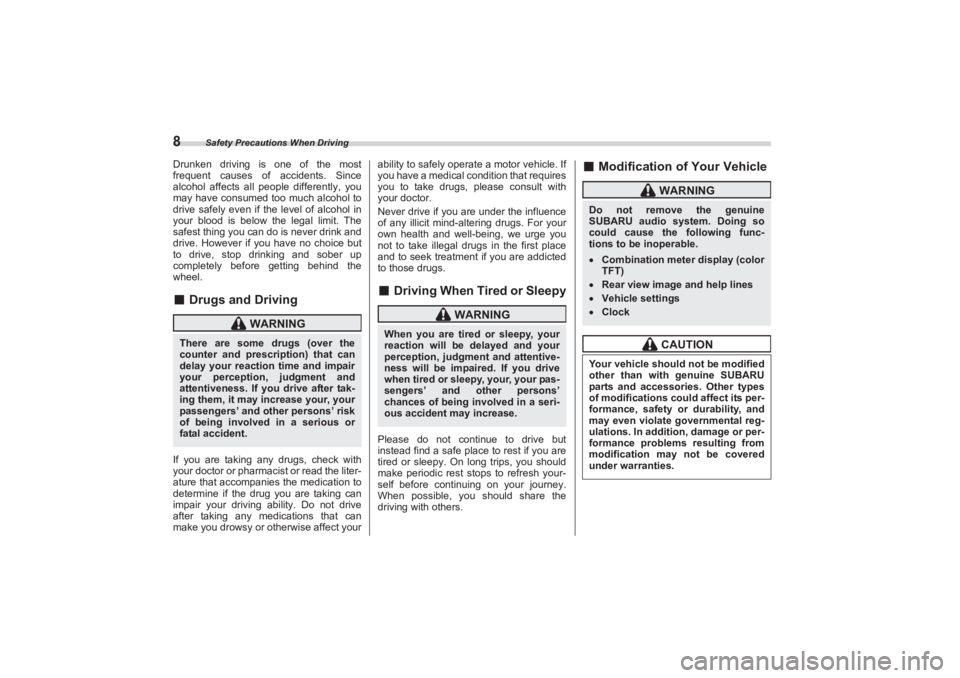
Safety Precautions When Driving
8Drunken driving is one of the most
frequent causes of accidents. Since
alcohol affects all people differently, you
may have consumed too much alcohol to
drive safely even if the level of alcohol in
your blood is below the legal limit. The
safest thing you can do is never drink and
drive. However if you have no choice but
to drive, stop drinking and sober up
completely before getting behind the
wheel.■ Drugs and DrivingIf you are taking any drugs, check with
your doctor or pharmacist or read the liter-
ature that accompanies the medication to
determine if the drug you are taking can
impair your driving ability. Do not drive
after taking any medications that can
make you drowsy or otherwise affect your ability to safely operate a motor vehicle. If
you have a medical condition that requires
you to take drugs, please consult with
your doctor.
Never drive if you are under the influence
of any illicit mind-altering drugs. For your
own health and well-being, we urge you
not to take illegal drugs in the first place
and to seek treatment if you are addicted
to those drugs.
■ Driving When Tired or SleepyPlease do not continue to drive but
instead find a safe place to rest if you are
tired or sleepy. On long trips, you should
make periodic rest stops to refresh your-
self before continuing on your journey.
When possible, you should share the
driving with others.
■ Modification of Your Vehicle
WARNING
There are some drugs (over the
counter and prescription) that can
delay your reaction time and impair
your perception, judgment and
attentiveness. If you drive after tak-
ing them, it may increase your, your
passengers’ and other persons’ risk
of being involved in a serious or
fatal accident.
WARNING
When you are tired or sleepy, your
reaction will be delayed and your
perception, judgment and attentive-
ness will be impaired. If you drive
when tired or sleepy, your, your pas-
sengers’ and other persons’
chances of being involved in a seri-
ous accident may increase.
WARNING
Do not remove the genuine
SUBARU audio system. Doing so
could cause the following func-
tions to be inoperable. Combination meter display (color
TFT) Rear view image and help linesVehicle settingsClock
CAUTION
Your vehicle should not be modified
other than with genuine SUBARU
parts and accessories. Other types
of modifications could affect its per-
formance, safety or durability, and
may even violate governmental reg-
ulations. In addition, damage or per-
formance problems resulting from
modification may not be covered
under warranties.
BRZ_U.book 8 ページ 2022年3月29日 火曜日 午後3時59分
Page 45 of 432
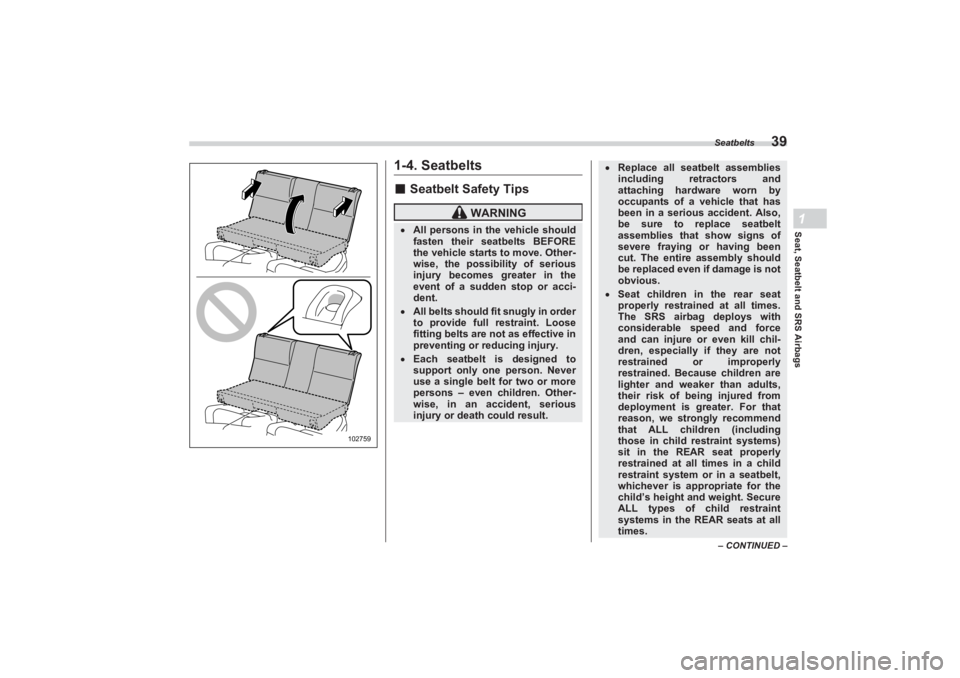
Seatbelts
39
Seat, Seatbelt and SRS Airbags1
– CONTINUED –
1-4. Seatbelts■Seatbelt Safety Tips
102759
WARNING
All persons in the vehicle should
fasten their seatbelts BEFORE
the vehicle starts to move. Other-
wise, the possibility of serious
injury becomes greater in the
event of a sudden stop or acci-
dent. All belts should fit snugly in order
to provide full restraint. Loose
fitting belts are not as effective in
preventing or reducing injury. Each seatbelt is designed to
support only one person. Never
use a single belt for two or more
persons – even children. Other-
wise, in an accident, serious
injury or death could result.
Replace all seatbelt assemblies
including retractors and
attaching hardware worn by
occupants of a vehicle that has
been in a serious accident. Also,
be sure to replace seatbelt
assemblies that show signs of
severe fraying or having been
cut. The entire assembly should
be replaced even if damage is not
obvious. Seat children in the rear seat
properly restrained at all times.
The SRS airbag deploys with
considerable speed and force
and can injure or even kill chil-
dren, especially if they are not
restrained or improperly
restrained. Because children are
lighter and weaker than adults,
their risk of being injured from
deployment is greater. For that
reason, we strongly recommend
that ALL children (including
those in child restraint systems)
sit in the REAR seat properly
restrained at all times in a child
restraint system or in a seatbelt,
whichever is appropriate for the
child’s height and weight. Secure
ALL types of child restraint
systems in the REAR seats at all
times.
BRZ_U.book 39 ページ 2022年3月29日 火曜日 午後3時59分
Page 89 of 432
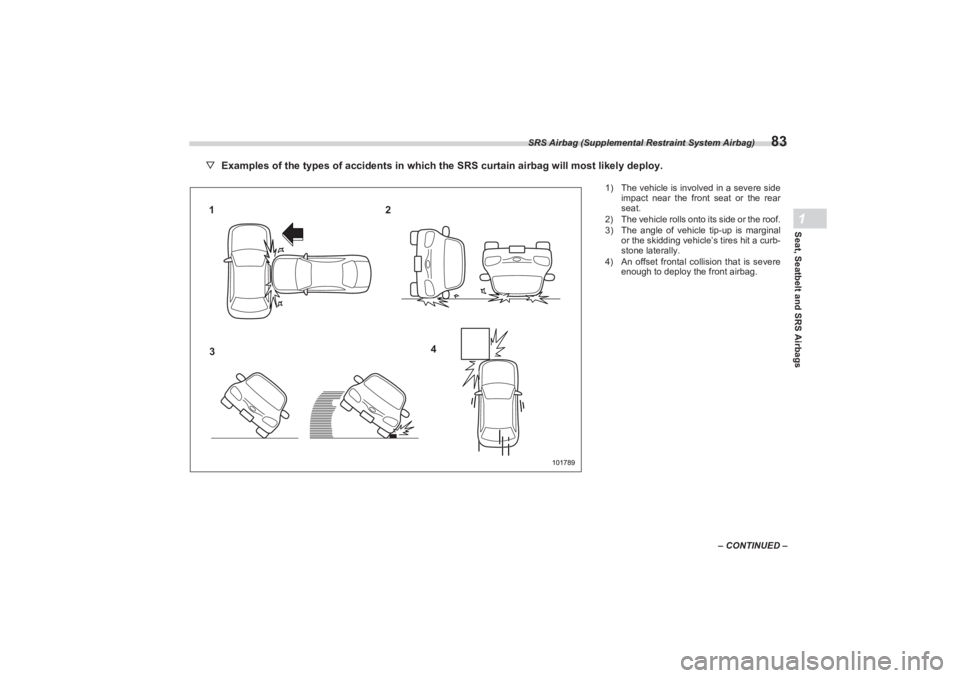
SRS Airbag (Supplemental Restraint System Airbag)
83
Seat, Seatbelt and SRS Airbags1
– CONTINUED –
▽Examples of the types of accidents in which the SRS curtain airbag will most likely deploy.
101789
3
12
4
1) The vehicle is involved in a severe side
impact near the front seat or the rear
seat.
2) The vehicle rolls onto its side or the roof.
3) The angle of vehicle tip-up is marginal or the skidding vehicle’s tires hit a curb-
stone laterally.
4) An offset frontal collision that is severe
enough to deploy the front airbag.
BRZ_U.book 83 ページ 2022年3月29日 火曜日 午後3時59分
Page 254 of 432
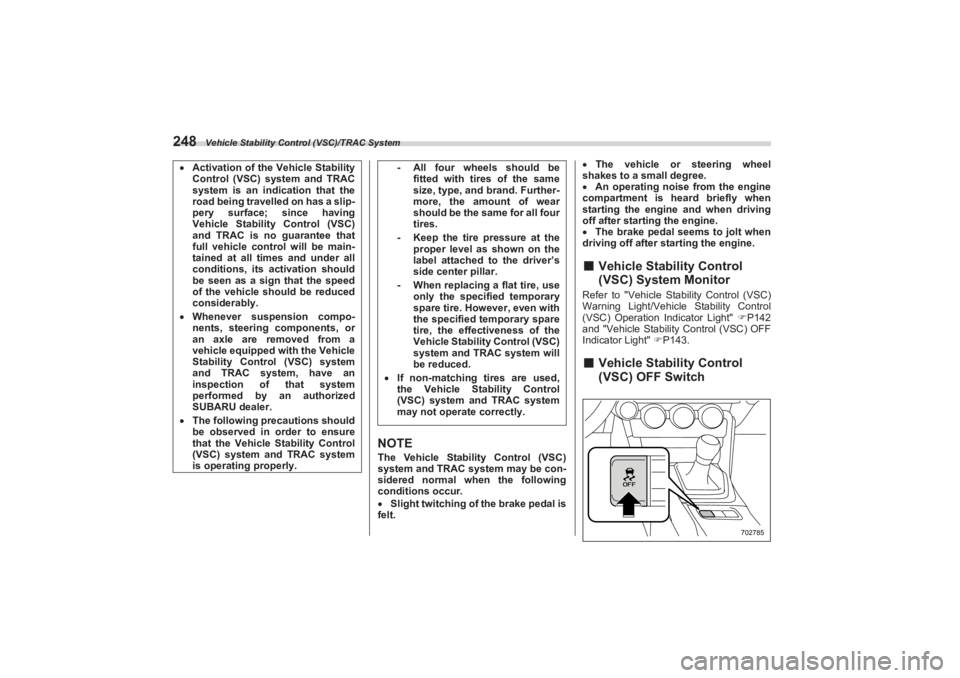
Vehicle Stability Control (VSC)/TRAC System
248
NOTEThe Vehicle Stability Control (VSC)
system and TRAC system may be con-
sidered normal when the following
conditions occur.
Slight twitching of the brake pedal is
felt.
The vehicle or steering wheel
shakes to a small degree.
An operating noise from the engine
compartment is heard briefly when
starting the engine and when driving
off after starti ng the engine.
The brake pedal seems to jolt when
driving off after st arting the engine.
■Vehicle Stability Control
(VSC) System MonitorRefer to "Vehicle Stability Control (VSC)
Warning Light/Vehicle Stability Control
(VSC) Operation Indicator Light" P142
and "Vehicle Stability Control (VSC) OFF
Indicator Light" P143.■ Vehicle Stability Control
(VSC) OFF Switch
Activation of the Vehicle Stability
Control (VSC) system and TRAC
system is an indication that the
road being travelled on has a slip-
pery surface; since having
Vehicle Stability Control (VSC)
and TRAC is no guarantee that
full vehicle control will be main-
tained at all times and under all
conditions, its activation should
be seen as a sign that the speed
of the vehicle should be reduced
considerably. Whenever suspension compo-
nents, steering components, or
an axle are removed from a
vehicle equipped with the Vehicle
Stability Control (VSC) system
and TRAC system, have an
inspection of that system
performed by an authorized
SUBARU dealer. The following precautions should
be observed in order to ensure
that the Vehicle Stability Control
(VSC) system and TRAC system
is operating properly.
- All four wheels should be
fitted with tires of the same
size, type, and brand. Further-
more, the amount of wear
should be the same for all four
tires.- Keep the tire pressure at the
proper level as shown on the
label attached to the driver’s
side center pillar.- When replacing a flat tire, use
only the specified temporary
spare tire. However, even with
the specified temporary spare
tire, the effectiveness of the
Vehicle Stability Control (VSC)
system and TRAC system will
be reduced.
If non-matching tires are used,
the Vehicle Stability Control
(VSC) system and TRAC system
may not operate correctly.
702785
BRZ_U.book 248 ページ 2022年3月29日 火曜日 午後3時59分
Page 302 of 432
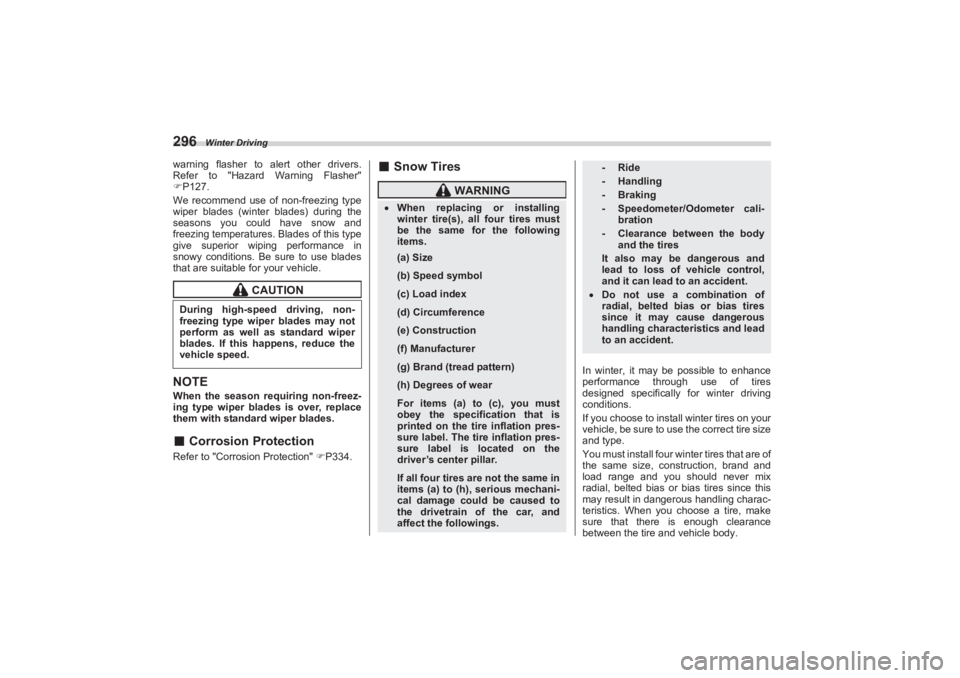
Winter Driving
296warning flasher to alert other drivers.
Refer to "Hazard Warning Flasher"
P127.
We recommend use of non-freezing type
wiper blades (winter blades) during the
seasons you could have snow and
freezing temperatures. Blades of this type
give superior wiping performance in
snowy conditions. Be sure to use blades
that are suitable for your vehicle.NOTEWhen the season requiring non-freez-
ing type wiper blades is over, replace
them with standard wiper blades.■ Corrosion ProtectionRefer to "Corrosion Protection" P334.
■ Snow Tires
In winter, it may be possible to enhance
performance through use of tires
designed specifically for winter driving
conditions.
If you choose to install winter tires on your
vehicle, be sure to use the correct tire size
and type.
You must install four winter tires that are of
the same size, construction, brand and
load range and you should never mix
radial, belted bias or bias tires since this
may result in dangerous handling charac-
teristics. When you choose a tire, make
sure that there is enough clearance
between the tire and vehicle body.
CAUTION
During high-speed driving, non-
freezing type wiper blades may not
perform as well as standard wiper
blades. If this happens, reduce the
vehicle speed.
WARNING
When replacing or installing
winter tire(s), all four tires must
be the same for the following
items.
(a) Size(b) Speed symbol(c) Load index(d) Circumference(e) Construction(f) Manufacturer(g) Brand (tread pattern)(h) Degrees of wearFor items (a) to (c), you must
obey the specification that is
printed on the tire inflation pres-
sure label. The ti re inflation pres-
sure label is located on the
driver’s center pillar.If all four tires are not the same in
items (a) to (h), serious mechani-
cal damage could be caused to
the drivetrain of the car, and
affect the followings.
-Ride-Handling- Braking- Speedometer/Odometer cali-
bration- Clearance between the body
and the tires
It also may be dangerous and
lead to loss of vehicle control,
and it can lead to an accident.
Do not use a combination of
radial, belted bias or bias tires
since it may cause dangerous
handling characteristics and lead
to an accident.
BRZ_U.book 296 ページ 2022年3月29日 火曜日 午後3時59分
Page 303 of 432
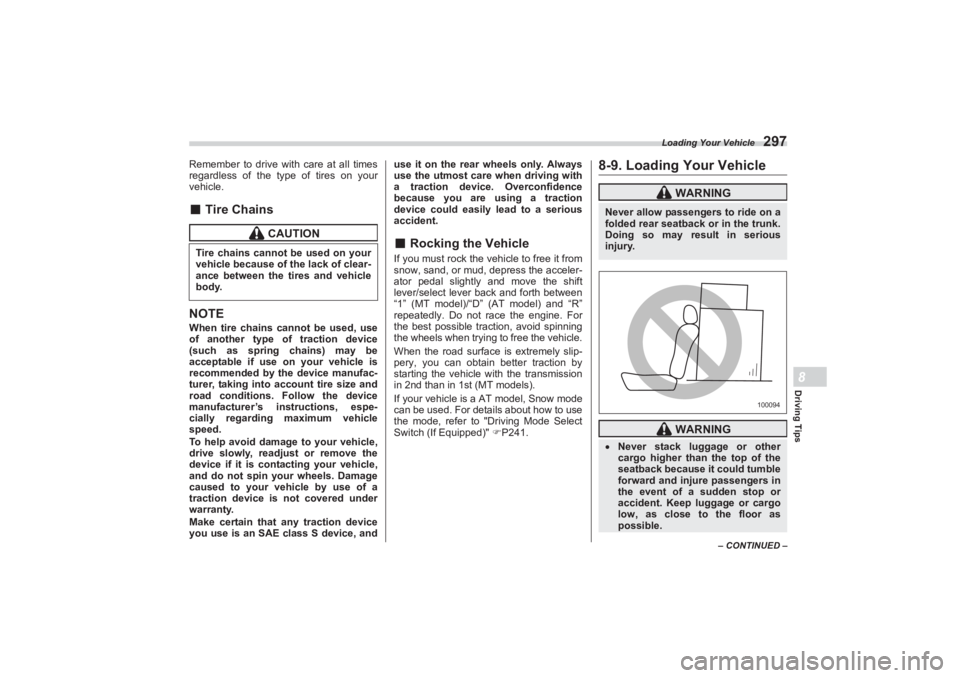
Loading Your Vehicle
297
Driving Tips8
– CONTINUED –
Remember to drive with care at all times
regardless of the type of tires on your
vehicle.■ Tire Chains
NOTEWhen tire chains cannot be used, use
of another type of traction device
(such as spring chains) may be
acceptable if use on your vehicle is
recommended by the device manufac-
turer, taking into account tire size and
road conditions. Follow the device
manufacturer’s instructions, espe-
cially regarding maximum vehicle
speed.
To help avoid damage to your vehicle,
drive slowly, readjust or remove the
device if it is contacting your vehicle,
and do not spin your wheels. Damage
caused to your vehicle by use of a
traction device is not covered under
warranty.
Make certain that any traction device
you use is an SAE class S device, and use it on the rear wheels only. Always
use the utmost care when driving with
a traction device. Overconfidence
because you are using a traction
device could easily lead to a serious
accident.
■ Rocking the VehicleIf you must rock the v ehicle to free it from
snow, sand, or mud, depress the acceler-
ator pedal slightly and move the shift
lever/select lever back and forth between
“1” (MT model)/“D” (AT model) and “R”
repeatedly. Do not race the engine. For
the best possible traction, avoid spinning
the wheels when trying to free the vehicle.
When the road surface is extremely slip-
pery, you can obtain better traction by
starting the vehicle with the transmission
in 2nd than in 1st (MT models).
If your vehicle is a AT model, Snow mode
can be used. For details about how to use
the mode, refer to "Driving Mode Select
Switch (If Equipped)" P241.
8-9. Loading Your Vehicle
CAUTION
Tire chains cannot be used on your
vehicle because of the lack of clear-
ance between the tires and vehicle
body.
WARNING
Never allow passengers to ride on a
folded rear seatback or in the trunk.
Doing so may result in serious
injury.
WARNING
Never stack luggage or other
cargo higher than the top of the
seatback because it could tumble
forward and injure passengers in
the event of a sudden stop or
accident. Keep luggage or cargo
low, as close to the floor as
possible.
100094
BRZ_U.book 297 ページ 2022年3月29日 火曜日 午後3時59分
Page 313 of 432
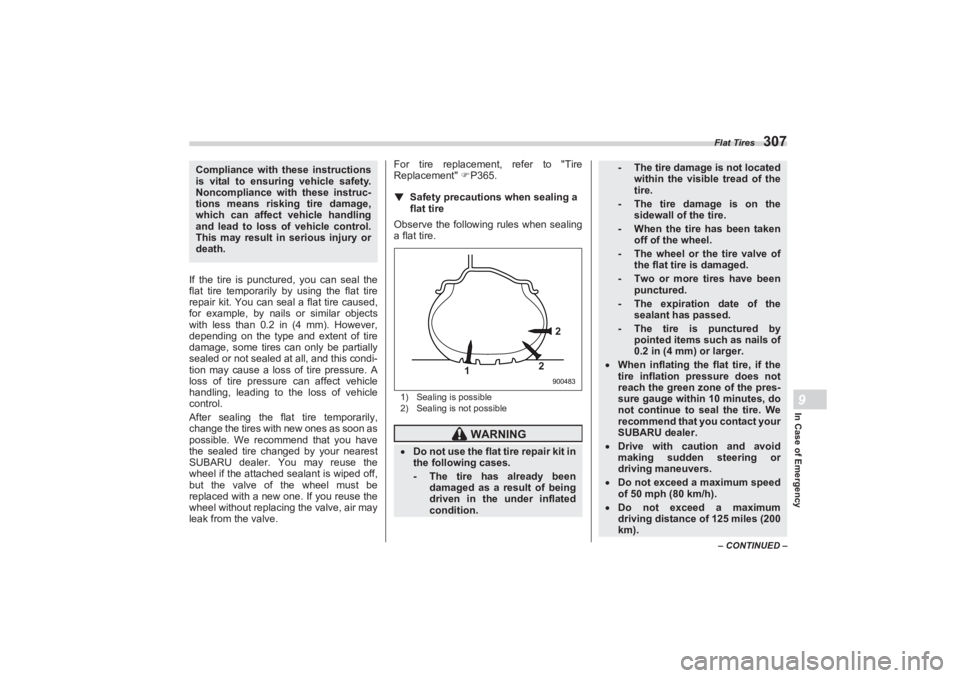
Flat Tires
307
In Case of Emergency9
– CONTINUED –
If the tire is punctured, you can seal the
flat tire temporarily by using the flat tire
repair kit. You can seal a flat tire caused,
for example, by nails or similar objects
with less than 0.2 in (4 mm). However,
depending on the type and extent of tire
damage, some tires can only be partially
sealed or not sealed at all, and this condi-
tion may cause a loss of tire pressure. A
loss of tire pressure can affect vehicle
handling, leading to the loss of vehicle
control.
After sealing the flat tire temporarily,
change the tires with new ones as soon as
possible. We recommend that you have
the sealed tire changed by your nearest
SUBARU dealer. You may reuse the
wheel if the attached sealant is wiped off,
but the valve of the wheel must be
replaced with a new one. If you reuse the
wheel without replacing the valve, air may
leak from the valve. For tire replacement, refer to "Tire
Replacement" P365.
▼ Safety precautions when sealing a
flat tireObserve the following rules when sealing
a flat tire.1) Sealing is possible
2) Sealing is not possible
Compliance with these instructions
is vital to ensuring vehicle safety.
Noncompliance with these instruc-
tions means risking tire damage,
which can affect vehicle handling
and lead to loss of vehicle control.
This may result in serious injury or
death.
WARNING
Do not use the flat tire repair kit in
the following cases.
- The tire has already been
damaged as a result of being
driven in the under inflated
condition.
900483
1 2
2
- The tire damage is not located
within the visible tread of the
tire.- The tire damage is on the
sidewall of the tire.- When the tire has been taken
off of the wheel.- The wheel or the tire valve of
the flat tire is damaged.- Two or more tires have been
punctured.- The expiration date of the
sealant has passed.- The tire is punctured by
pointed items such as nails of
0.2 in (4 mm) or larger.
When inflating the flat tire, if the
tire inflation pressure does not
reach the green zone of the pres-
sure gauge within 10 minutes, do
not continue to seal the tire. We
recommend that you contact your
SUBARU dealer. Drive with caution and avoid
making sudden steering or
driving maneuvers. Do not exceed a maximum speed
of 50 mph (80 km/h). Do not exceed a maximum
driving distance of 125 miles (200
km).
BRZ_U.book 307 ページ 2022年3月29日 火曜日 午後3時59分
Page 343 of 432

Maintenance and Service11
Maintenance and Service
11-1. Maintenance Schedule .....................................339
11-2. Maintenance Precautions.................................339
Before Checking or Servicing in the Engine
Compartment ..............................................................340
When Checking or Servicing in the Engine Compartment ..............................................................340
When Checking or Servicing in the Engine Compartment While the Engine Is Running ............341
11-3. Maintenance Tips ..............................................341
Removing and Reinstalling Clips................................341
11-4. Engine Hood ......................................................343
11-5. Engine Compartment Overview.......................345
11-6. Engine Oil ..........................................................346
Engine Oil Consumption..............................................346
Checking the Oil Level .................................................346
Changing the Oil and Oil Filter ....................................347
Recommended Grade and Viscosity ..........................347
Synthetic Oil..................................................................348
11-7. Cooling System .................................................348
Cooling Fan, Hose and Connections ..........................348
Engine Coolant .............................................................349
11-8. Air Cleaner Element ..........................................350
Replacing the Air Cleaner Element .............................350
11-9. Spark Plugs .......................................................352
Recommended Spark Plugs ........................................352
11-10. Drive Belt .........................................................352
11-11. Automatic Transmission Fluid ......................352
Recommended Grade and Viscosity ..........................352
11-12. Differential Gear Oil ........................................353
Recommended Grade and Viscosity ..........................353
11-13. Manual Transmission Oil ...............................353
Recommended Grade and Viscosity ..........................353
11-14. Brake Fluid ......................................................353
Checking the Fluid Level ............................................ 353
Recommended Brake Fluid ........................................ 354
11-15. Clutch Fluid (MT models) ...............................354
Checking the Fluid Level ............................................ 354
Recommended Clutch Fluid ....................................... 355
11-16. Brake Booster .................................................355
11-17. Brake Pedal .....................................................356
11-18. Clutch Pedal (MT models) ..............................356
11-19. Replacement of Brake Pad and Lining..........356
Breaking-in of New Brake Pads and Linings ............ 357
11-20. Parking Brake Stroke ......................................357
11-21. Tires and Wheels ............................................358
Types of Tires .............................................................. 358
Tire Pressure Monito ring System (TPMS)
(If Equipped)............................................................... 358
Tire Inspection ............................................................. 360
Tire Pressures and Wear............................................. 361
Wheel Balance ............................................................. 363
Wear Indicators ............................................................ 363
Rotational Direction of Tires....................................... 364
Tire Rotation................................................................. 364
Tire Replacement ...... ............................. ...................... 365
Wheel Replacement ..................................................... 365
11-22. Alloy Wheels ....................................................366
11-23. Windshield Washer Fluid ...............................366
11-24. Replacement of Wiper Blades........................367
Windshield Wiper Blade Assembly ............................ 368
Windshield Wiper Blade Rubber ................................ 369
11-25. Battery ..............................................................370
11-26. Fuses ................................................................371
11-27. Installation of Acce ssories ............................373
BRZ_U.book 337 ページ 2022年3月29日 火曜日 午後3時59分